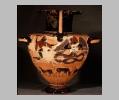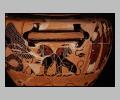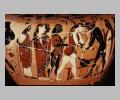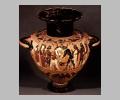
Overview: side B

Handle: right of side B

Side A: Atalante wrestling Peleus, with onlookers on left

Overview: side A
| Collection: | Munich, Antikensammlungen |
| Summary: | Side A: Atalante wrestles with Peleus |
| Ware: | Chalcidian Black Figure |
| Date: | ca 540 BC |
| Dimensions: | Height 0.46 m. |
| Primary Citation: | |
| Shape: | Hydria |
| Period: | Archaic |
Decoration Description:
Side A: Atalante wrestles with Peleus in the presence of spectators. The main figures and two of the spectators on the right are labelled. Victorious Atalante on the left wears a short, red chiton with a white belt. Peleus is nude, bearded and wears his hair tied up. His face, beard and neck are accented in red paint. The skin of the Chalcidian boar suspended in the background is rendered in outline incision. On a low table in front of it lies the decapitated head of the boar, with dripping blood indicated in red. From the right Mopsos is watching, holding a spear in his right. He is depicted bearded, with long hair, and wearing a white garment with patterned seams and a red mantle. His neck is red. The initial sketching is visible on the hand of Mopsos and along the back of Peleus, and does not correspond with the final rendering. Behind Mopsos stands Klytios, also bearded and long-haired, wearing a red mantle and carrying a staff on his shoulder. The two are followed by another older male dressed similarly. On the left stands a bearded man wearing a long, white garment and a red mantle. He is followed by a long-haired youth, a woman dressed with a red peplos and a himation, and a bearded man in a white long garment and a red himation.
The red paint is usually applied onto a glaze, the white is directly painted onto the clay background. Outlines and interior details are generally incised; white surfaces are indicated by lines of thinned glaze.
Side B: Zeus, who is labelled with an inscription, is rendered bearded and long-haired and wears a short red tunic. He holds the thunderbolt in his left and fights in "Knielaufstellung" against Typhon. Typhon is depicted frontally and facing left. His hair, beard, and Silenus' ears are indicated in red. He wears a sleeveless white chiton with the two intertwined snake tails extending below. His wings are spread and he holds his hands in a protective gesture in front of his body. The scene is rendered with much use of incision and red paint, with white accents applied onto varnish.
Below the horizontal handles are two lions seated opposite from each other and facing backward. Their manes are rendered in red. At the bottom of each handle is a stemmed blossom with a red central dot. The shoulder of the hydria shows a frieze of young men on horse-back, wearing short, red chitons and long hair. Ornamental rosettes decorate the field surrounding them. Above them is a band of black and red tongs.
Below the main scenes runs a decorative animal frieze showing a siren flanked by panthers, a bird looking backward, grazing rams and another panther. Several rosettes decorate the field. The frieze is framed by a band of stepped decoration above and a band of rays below.
The battle of Atalante and Peleus occurs during the funerary games for Pelias during the travels of the Argonauts. The scene is identified by the presence of the spectators Klytios and Mopsos and the skin and head of the Calydonian boar as trophies and characteristic attributes of Atalante in the background. The fight between Zeus and Typhon appears repeatedly on Argivo-Corinthian bronze reliefs, which are generally older than the hydria. In comparison to the images from the mainland the rendering of the battle scene is less dramatic. The two fighting figures do not overlap and they both dominate equal space to the right and left of the vertical handle. Typhon does not show a gesture of submission and allows Zeus to strike him down. The static positions of the wings and snake tails enforce the character of this image.
Material Description:
Orange-red, fine ware; black glaze with metallic luster; red and white accents.
Inscriptions:
The figures in the main image are labelled. Side A:
Sources Used:
Other Bibliography:

